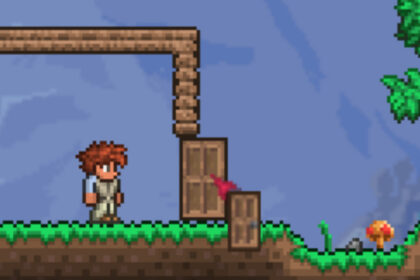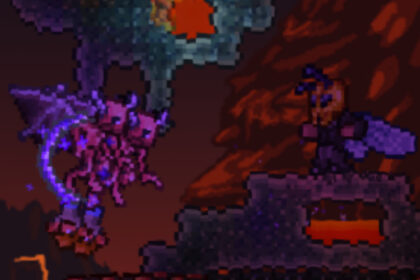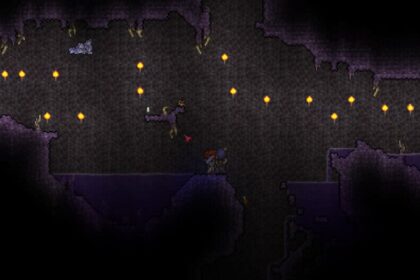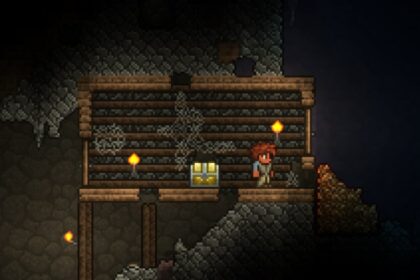The difficulty of Plantera is a step up from any prior Terraria bosses, and defeating her is a pivotal moment in any player’s adventure. She is found in the depths of the underground Jungle biome and, when beaten, makes an array of new content available to you.
Defeating Plantera is a tough challenge for most Terraria players.
This is especially true in Expert mode, where most enemies deal more damage, have more health, and take less knockback.
However, while the difficulty is greatly increased, so are the rewards. Expert mode means that enemies have better drops and a higher chance of dropping most items. On top of this, there are some items exclusive to Expert mode.
This Terraria Plantera Expert guide will explain the ins and outs of defeating Plantera in Expert mode, as well as how to spawn her.
Following this guide will minimize the number of attempts you make…but fair warning: it still might take a few attempts!
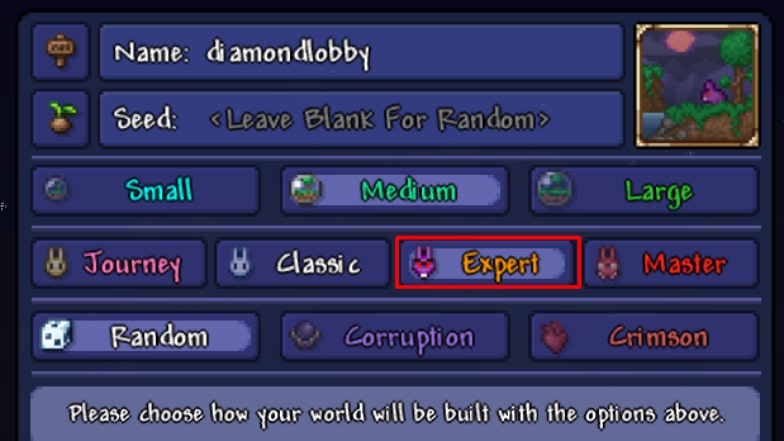
What is Plantera?
Plantera is a late-game boss, spawnable after defeating the three Mechanical Bosses (Skeletron Prime, The Destroyer, and The Twins) and all bosses prior. She is spawnable in the depths of the underground Jungle and proves a challenge to new and experienced players alike.
Upon being defeated, Plantera will drop a Temple Key, allowing access to the Jungle Temple. Finding the Jungle Temple can be a challenge, but at this point in the game, traversing the Jungle and killing its enemies can be done with relative ease.
To spawn Plantera, you must destroy a Plantera’s Bulb – a background tile found in the underground Jungle after defeating the three Mechanical Bosses. A status message will spawn after defeating the Mechanical Bosses saying, “The jungle grows restless…”, indicating that Plantera’s Bulbs have started to spawn.
Plantera’s Bulbs spawn randomly in the underground Jungle, one at a time, with approximately half a Terraria day between each Bulb spawning. Unless destroyed, Plantera’s Bulbs will keep spawning throughout the underground Jungle, reaching a maximum of around 15 in large worlds. This means that you can spawn Plantera as many times as you like. However, once you destroy a Plantera’s Bulb, it’s highly unlike to respawn in the same place.
You can destroy Plantera’s Bulbs using a drill or pickaxe, by placing a block, or by using a Clentaminator with any solution except Green Solution. This means that it’s entirely possible to spawn Plantera accidentally, so you should always be careful exploring the underground Jungle once you’ve seen the message “The jungle grows restless…”.
The Fight
Plantera is a complex boss, and there are two main stages of fighting her. Plantera initially appears as a giant pink Bulb but later develops into a carnivorous plant-looking entity. She will always try to chase after you, with her goal being getting her main bulb over your space – this is when Plantera deals the most damage. This means that when fighting Plantera, mobility and kiting ability is crucial.
She moves around by grappling onto the surroundings with vines. By clearing an area, you can inhibit her movement. It’s worth noting that Plantera can also attach to background walls, so they must also be cleared out in order to restrict her movement.
The second phase begins when Plantera reaches 50% health. Her petals fall off, revealing an aggressive-looking maw. She becomes faster, deals more damage, gains more defense, and attacks more frequently. This is by far the most difficult stage of the boss. Even with complete preparation, the right equipment, and the recommended damage output, the second stage of Plantera is what catches most players out.
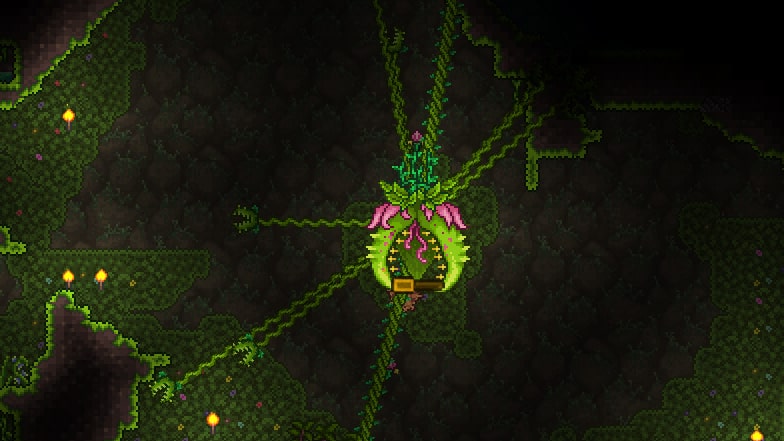
Throughout the fight, Plantera has five types of attacks: Seeds, Thorn Balls, Hooks, Biters, and Spores. Seeds and Thorn Balls are exclusive to the first stage of Plantera, whereas Biters and Spores are exclusive to her second stage. Hooks appear in both stages of fighting the boss.
Seeds are projectiles that Plantera will fire. They are similar to the projects of a Hornet. They cannot travel through solid blocks. Thorn Balls will typically stay on the ground for a considerable amount of time and deal a lot of damage if you come into contact with one; however, Plantera’s Thorn Balls will seek out the player in Expert mode.
Biters are similar to the Wall of Flesh’s “The Hungry” and will spawn as soon as Plantera reaches 50% health and loses her petals. They are attached to Plantera on vines and, while being relatively easy to kill, can deal massive damage if not dealt with quickly. Similarly, Spores are projectiles that are easy to destroy but can deal huge amounts of damage if not killed swiftly.
Finally, Hooks are on the ends of the large vines that Plantera uses to move around. They will deal a lot of damage if you come into contact with them, but they are fairly easy to avoid – especially with the correct mobility items.
Boss Arena
Boss arenas are a vital part of most boss fights in Terraria, from defeating Skeletron to defeating the Moon Lord. Because Plantera is such an unusual boss in terms of movement and location, it’s important to build a boss arena appropriate for these conditions. You should prepare your boss arena near the Plantera Bulb you intend on using to summon this boss.
Clearing out a large area of the underground Jungle is a good starting point for building your boss arena. You should keep in mind, however, that if the cleared area is too large, it may no longer be considered an underground Jungle biome. Because Plantera becomes enraged when leaving the Jungle – becoming much faster, gaining more defense, and dealing more damage – it’s best to maintain the area as underground Jungle biome.

Ensuring that you have cleared a lot of space is essential as mobility is arguably more important against Plantera than any other boss in Terraria. Once you have cleared a large area, you should line the area with platforms. The platforms should go across about a screen length – slightly more if possible – and be several vertical layers high. Each layer of platforms should have a gap of 7-10 tiles, and there should be a minimum of 5 layers.
Scattered around your boss arena should be the ever-useful Campfires and Heart Lanterns. These will increase health regeneration while you are near them, so it’s practical to put them in positions such that you will always be under the effect of at least one of them. Campfires and Heart Lanterns act as background blocks. This means that they won’t inhibit movement in any way.
Additionally, a common strategy to use for boss arenas is pools of honey. Honey provides the “Honey” buff, a buff that also increases health regeneration. By trapping honey in balloon blocks, you can pass through the honey easily, therefore gaining the extra regeneration. The accumulation of Campfires, Heart Lanterns, and the “Honey” buff substantially increases health regeneration, making Plantera considerably more manageable.

Heart Statues can also be used to give small bursts of healing as required. When wired up to a timer, Heart Statues will drop Hearts that restore small amounts of health when picked up. It’s worth noting that only three Hearts can be spawned in a small area at a time; however, more can be spawned by spreading the Heart Statues out. Heart Statues can be found randomly underground, primarily in Underground Cabins.
Another great way to restore health is building a house for the Nurse NPC in or near your boss arena. The Nurse can immediately fully restore your health. This is an invaluable ability – particularly in Expert mode, where enemies’ damage is substantially increased.
Similarly, building a house for the Dryad is recommended. The Dryad grants a buff to nearby players called the “Dryad’s Blessing” when enemies are nearby. This buff increases defense, health regeneration and provides a thorns effect. The thorns effect means that 50% of damage taken by the person with the buff is reflected onto the attacker.
Finally, an essential tool for magic users is the Star in a Bottle. Scattering these across your boss arena will increase mana regeneration. You can get a Star in a Bottle through crafting, using 1 Fallen Star and 1 (empty) Bottle.
Melee Class Setup
The melee class setup can be an effective choice against Plantera due to her attempts to be on the same tiles as you. These attempts mean that you’ll likely often be in close proximity to Plantera. This acts as the perfect opportunity for the melee class setup to deal damage.
Combined with a strong defense and the bonus health regeneration, this is a solid strategy against Plantera. You should ensure you have the maximum 500 health for this fight.
Armor
There are many different armor options for fighting Plantera, especially when using the melee class setup. The best offensive armor set for the melee class setup isn’t a true set. It consists of the Chlorophyte Mask, Monk’s Shirt, and Squire’s Greaves. This may seem like an unlikely combination; however, the offensive capabilities alongside the high defense it provides are unparalleled.
If you prefer a fully defensive build, you should use Turtle Armor. Turtle Armor is another viable armor set for fighting Plantera in Expert mode as it provides the highest flat defense values accessible at this point in Terraria. Additionally, the full set offers a significantly increased “thorns” effect at melee range – reflecting twice the damage of incoming melee attacks to the attacker.
While Turtle Armor is a great choice, it is difficult to obtain. The Giant Tortoise is a rare enemy that has a 5.88% chance of dropping a single Turtle Shell when killed. This means that, on average, you’d need to defeat 140 Giant Tortoises for a 99% chance of getting 3 Turtle Shells.

Hallowed Armor is also viable for fighting Plantera in Expert mode. It’s worth noting that Hallowed Armor has four different headpiece choices. These are the Hallowed Helmet, Mask, Headgear, and Hood. Each headpiece is most suited for a different class setup. The best Hallowed headpiece for melee users is the Hallowed Mask.
Another great choice is a full set of Chlorophyte Armor is arguably better than Hallowed Armor, one of the reasons being the set bonus; a full set of Chlorophyte Armor will summon a turret-like leaf that will shoot enemies with no ammo or mana cost. Like the Hallowed set, Chlorophyte Armor has several different headpieces corresponding to different class setups. These are the Chlorophyte Mask, Helmet, and Headgear. The optimum choice for a melee user is the Chlorophyte Mask.
Weapons
The best weapon for melee users to use against Plantera is the Death Sickle. It deals high damage fires a projectile that travels 12 tiles, dealing damage upon impact with an enemy. The Death Sickle has a very fast use-time and the ability to auto-swing. Each swing will fire the mentioned projectile, meaning that, overall, the damage output from this weapon is massive. Additionally, the projectile comes at no mana or ammo cost.
The True Excalibur and True Night’s Edge are also solid choices for fighting Plantera in Expert mode. They have incredibly high base damage and fire projectiles in the direction they are swung – at no additional mana or ammo cost.
A yoyo that can be useful in fighting Plantera is the Yelets. Due to its high and consistent damage output from afar, it is the perfect choice for the first stage of Plantera, when you will likely outspeed her. The constant damage the Yelets provides will tear through Plantera’s first stage. However, changing weapons once you’re past the first phase of Plantera is highly recommended, as the Yelets will become pretty ineffective.
Ranged Class Setup
The ranged class setup is a solid choice throughout most stages of the game. Against Plantera, where kiting and dodging are a huge part of the boss fight, ranged attacks are invaluable. However, it’s important to ensure you don’t come into melee range with Plantera, as she will be tough to escape, and you will take much more damage than you’ll deal.
You should have the full 500 health when fighting Plantera in Expert mode. This, combined with the bonus health regeneration from Campfires, Heart Lanterns, and the “Honey” buff, will provide sufficient survivability.
Armor
Like the melee class setup, the best armor for rangers is a hybrid set consisting of the Hallowed Helmet, Huntress’s Jerkin, and Mythril Greaves. This will substantially increase ranged damage while simultaneously reducing the chance of ammo usage. Having the opportunity not to use ammo is crucial for rangers as ammo can get expensive – particularly mid to late game.

Hallowed Armor is a viable set to use as a ranger against Plantera in Expert mode. As mentioned previously, Hallowed Armor has four different headpiece options. The best one for a ranger is the Hallowed Helmet, as this will increase ranged damage and ranged critical strike chance.
Alternatively, Chlorophyte Armor is a slightly better choice. Using a Chlorophyte Helmet will increase the chance not to consume ammo by 20% as well as ranged damage by 16%. Additionally, the Chlorophyte Armor set bonus is very strong.
Titanium Armor can also be used, as the set bonus is great for additional defense. Like the Hallow and Chlorophyte Armor sets, Titanium Armor has different headpiece options. These are the Titanium Helmet, Mask, and Headgear. The best choice for a ranger is the Titanium Helmet. Titanium Armor grants a powerful, defensive set bonus that creates shards around you. Upon contact with an enemy, one of the many shards will deal damage and get destroyed. The cooldown for this is 10 seconds.
Weapons
There are three different weapon types available to rangers: guns, bows, and blasters. Guns typically fire faster than bows but have less special properties. The best guns available at this point in the game are the Uzi, Megashark, and the Onyx Blaster. None of them are inherently better than the other, so whichever one you use is up to availability and personal preference.

While there are many types of bullets in Terraria, it’s important to choose the most appropriate bullet for each scenario. Against Plantera in Expert mode, the most effective bullets to use are Crystal Bullets. It can be tough to find the resources required to make a large quantity of these; however, they are pretty much crucial for success against Expert mode Plantera.
If using bows to fight Plantera, you should use a Chlorophyte Shotbow. Holy or Ichor Arrows work best for fighting Plantera, and you should stock up on as many of these as possible. Alternatively, Chlorophyte Arrows will do just as good of a job; however, you may wish to save your Chlorophyte for other equipment. Additionally, Chlorophyte Arrows don’t inflict the same debuffs that Ichor or Holy Arrows do, meaning that, overall, they may not be as effective.
The Super Star Shooter is the only viable blaster for fighting Plantera, and it can be costly. Because the Super Star Shooter uses Fallen Stars as ammunition, it’s important to ensure that you don’t use it as your primary weapon. Having said that, it can be a fantastic secondary weapon for fighting Plantera’s second stage due to the piercing effect and high base damage.
Magic Class Setup
If you’re good at dodging enemies’ attacks, the magic class setup is the ideal one to use against Plantera in Expert mode. Typically, magic users have low defense and serious damage output, encouraging a “glass cannon” playstyle. Against Plantera, this can be very effective, especially with a properly-built boss arena. Having 500 health is an absolute necessity when fighting Plantera as a magic user.
Armor
The best armor set for magic users is, again, a hybrid. The hybrid set comprises Hallowed Headgear, Chlorophyte Plate Mail, and Apprentice’s Trousers. This will provide the maximum magic damage output available at this point in the game while also increasing maximum mana.
You can also use a Chlorophyte, Hallowed Armor, or Titanium set with the Headgear piece of each armor set. These will provide a solid foundation for you to build upon with weapons, potions, and playstyle. Sometimes, you may prefer a set bonus over raw damage, so you should always consider how you wish to play.
Weapons
Magic users have arguably the largest arsenal of weapons available to them at most points throughout the game. Although, there are only a few primary weapons to use against Plantera in Expert mode that will be most effective and maximize your damage output ability.
The Crystal Serpent is a solid starting point for magic users. It fires a single projectile that deals high initial damage but also splits into five smaller projectiles on contact with an enemy or block. This can make it practical in fighting the Biters and other similar enemies that spawn during the Plantera battle.
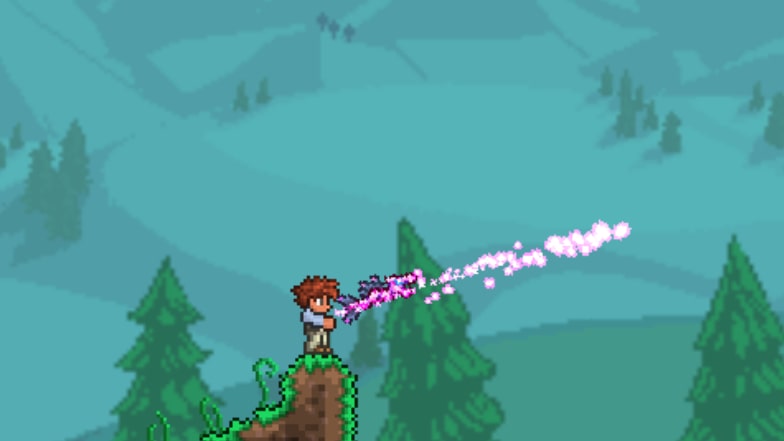
Another solid choice is the Sky Fracture. While it doesn’t have the most significant base damage, its unique properties ensure the damage output stacks up fast. Upon use, three swords will spawn behind you and fire in the direction of the cursor. This has a fast use time and low mana cost. Additionally, the Sky Fracture has a 24% base critical strike chance – this is 6x higher than the 4% of most weapons.
The Golden Shower is recommended as a secondary weapon as it inflicts the “Ichor” debuff to enemies. The Ichor debuff decreases the afflicted enemy’s defense by 15, thus further increasing your damage output.
Summoner Class Setup
The summoner class setup is one that progressively gets stronger throughout the game. Because Plantera is a mid to late-game boss, playing as a summoner against her is entirely viable. Although the armor and weapon options are very limited, the equipment needed to fight Plantera isn’t especially difficult to obtain. This is particularly true for the weapons.
Having 500 health is important as a summoner as a precautionary measure. While it’s unlikely you’ll be getting close to Plantera, it’s essential to have sufficient health, just in case. Additionally, the projectiles she fires can be difficult to avoid, so having 500 health makes the failure to dodge them less punishing.
Armor
Spider Armor is, by far, the best summoner armor to use against Plantera, especially in Expert mode – where the game is considerably less forgiving. Unfortunately, Spider Armor can be pretty difficult to acquire as the recipe for each piece is 1 Spider Fang. While Spider Fangs aren’t particularly rare drops, it can be difficult to find a Spider Cave, especially in large worlds. However, considering there is no comparable alternative set at this point in the game, getting Spider Armor is necessary if you wish to play as a summoner.
Having said that, there is a hybrid set that is viable, although it is still predominantly Spider Armor. This hybrid set simply replaces the Spider Breastplate with the Squire’s Plating. Doing so will sacrifice one minion slot for an extra 19 defense.
Weapons
Like the armor suitable for a summoner against Plantera, there is a very limited choice of viable weapons at this point in the game. There are two weapons that a summoner can use to fight Expert mode Plantera as a summoner. Luckily, neither of these weapons is especially difficult to obtain.
The first is the Sanguine Staff. In Expert mode, it’s a guaranteed drop from killing a Dreadnautilus – an enemy that spawns in hardmode during a Blood Moon. It summons a Sanguine Bat that will fight by your side, dealing high, frequent damage and a lot of knockback.
Secondly, the Blade Staff can be used against Plantera. It has low base damage but ignores 25 of the target’s defense, meaning it can deal a lot of damage overall. You can obtain it by killing Queen Slime, with a 33% chance of dropping in Expert mode. The Blade Staff will summon an Enchanted Dagger above your head that will rapidly move toward and through enemies within its range. It does this repeatedly.
Accessories
While there are class-exclusive accessories, the majority of accessories you’ll be using to fight Plantera are universal. It’s important to remember that you should have six accessory slots in Expert mode post-Wall of Flesh. This is because the Wall of Flesh drops a Demon Heart – an accessory that grants your character an additional accessory slot for Expert mode worlds. Using Demon Hearts is simple and should always be done as soon as possible.
Wings
Wings are an integral part of gameplay in Terraria – extending out of boss fights and into standard gameplay. Having Wings is essential to success in Terraria, and without them, failure is likely. The type of Wings you have will determine the flight speed and duration. This means that it’s important to get the best wings you can to increase your chance of success.
There are three types of wings that you should consider when preparing to fight Plantera. These are the Leaf, Frozen, and Flame Wings. While the Frozen and Flame Wings are technically better – providing 2.67 seconds of flight and 150% flight speed – Leaf Wings are much easier to obtain and still boast solid stats.
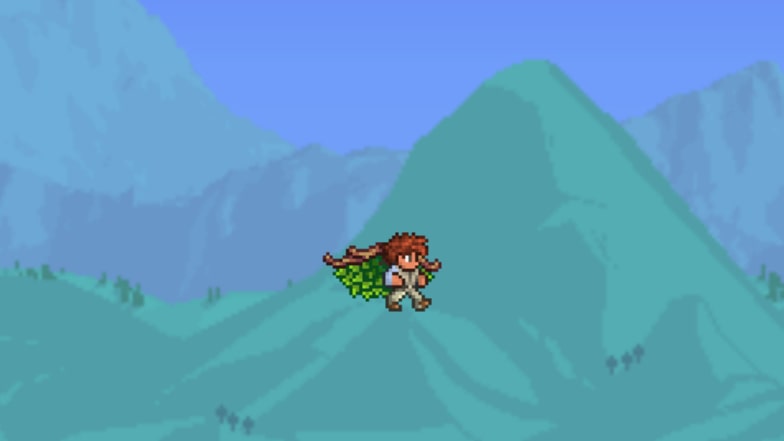
To get an Ice Feather (the crafting material needed for Frozen Wings, alongside 20 Souls of Flight), you must defeat an Ice Golem during a blizzard in the Snow biome. However, it only has a 33% chance of dropping from an Ice Golem.
Similarly, Fire Feathers (the crafting material needed for Flame Wings, alongside 20 Souls of Flight) can only be obtained from Red Devils, found in the Underworld (otherwise known as Hell) – with only a 1.33% chance of dropping.
On the other hand, Leaf Wings aren’t craftable and are instead purchased from the Witchdoctor NPC at night while he’s in a Jungle biome. They cost one platinum coin and have the same flight speed as the previously mentioned wings; however, their flight time is a second less.
Depending on the type of Wings you decide to go for, it’s worth considering making a biome to maximize farming efficiency. Creating a sufficient Snow biome will increase the chances of a blizzard occurring, as well as the spawn rate of Ice Golems during the said blizzard.
Shield of Cthulhu
The Shield of Cthulhu is an Expert mode-exclusive accessory. It provides invaluable utility and stats and is, therefore, an essential accessory to use when fighting Plantera in Expert mode. It’s a guaranteed drop from the Eye of Cthulhu Treasure Bag and should be used from that point onwards – it’s useful even when fighting the Moon Lord.
It allows you to quickly dash in either horizontal direction, granting temporary invincibility and dealing 30 damage upon impact with an enemy. Additionally, it deals high knockback and provides 2 defense. To activate this dash, simply double-tap the key assigned to the direction you wish to go in. For example, if your key set to moving left is “A”, double-tap “A” to activate the dash.
Class Emblems
In Terraria, there are different “Emblems” corresponding to each class. As well as that, when combined at a Tinkerer’s Workshop, the Emblems will create an Avenger Emblem – this provides a 12% damage boost to all weapons. However, crafting an Avenger Emblem isn’t necessary for success, and its class-specific predecessors will suffice.
The different types of Emblems are the Warrior, Summoner, Sorcerer, and Ranger Emblems. They increase the damage of their respective weapon types by 15%. Emblems aren’t craftable and have a 25% chance of dropping from the Wall of Flesh in Expert Mode. This means that Emblems are very easy to obtain early on in the game and should always be used from that point onwards.
Worm Scarf
The Worm Scarf is another Expert mode-exclusive accessory that will prove invaluable during any boss fight. When equipped, it reduced all incoming damage by 17%. This is hugely beneficial and can be obtained early on in the game. Having it equipped throughout the game is highly recommended.
To get the Worm Scarf, you must defeat the Eater of Worlds in Expert mode. When defeated, the Eater of Worlds will drop a Treasure Bag (this is exclusive to Expert Mode), and the Treasure Bag is guaranteed to contain a Worm Scarf. The Worm Scarf isn’t to be confused with Worm Food – an item that allows you to spawn the Eater of Worlds.
The 17% damage reduction is useful at every stage of the game and against any enemy.
Frozen Turtle Shell
Like the Worm Scarf, the Frozen Turtle Shell provides percentage damage reduction; however, it’s conditional. When at 50% health or below, the Frozen Turtle Shell will reduce incoming damage by 25%. While this is considerably more than the Worm Scarf, the Frozen Turtle Shell encourages “high risk, high reward” gameplay because of the requirement to be at 50% health or less to gain its effects. For those that this playstyle doesn’t suit, you can opt for the Worm Scarf instead.
Additionally, getting a Frozen Turtle Shell can be a time-consuming task. It has a 1% drop chance from Ice Tortoises. The Ice Tortoise is a rare enemy that spawns in the Snow Biome. They are identical in function to the Giant Tortoise (found in the Jungle biome) and only differ in appearance slightly.
Ankh Shield
Getting an Ankh Shield is important for many stages throughout the game. It provides immunity to knockback, fire blocks, and most debuffs (11 in total). On top of this, the Ankh Shield grants an extra 4 defense. Unfortunately, the Ankh Shield has a very complicated crafting tree, making it very difficult to obtain, even at later stages of the game. However, the utility that immunity to knockback and 11 different debuffs provides is massive, so don’t be put off by the complexity of the crafting tree.
Potions
The further you advance and progress through Terraria, the more important potions will become in your gameplay – particularly in Expert Mode, where their use is an absolute necessity. There are many potions and consumables that can aid you in your adventure; many of these are beneficial for combat against challenging enemies or bosses.
Ironskin and Endurance Potions will significantly increase survivability, with the Ironskin Potion increasing defense by 8 and lasting 8 minutes, and the Endurance Potion reducing all incoming damage by 10%. The Endurance Potion synergizes well with the Worm Scarf and Frozen Turtle Shell, which further decrease the incoming damage.
To further improve your survivability, using Regeneration and Lifeforce Potions is highly recommended. Regeneration Potions last for 8 minutes and heal you for 2 health per second for the duration. On the other hand, Lifeforce Potions will increase your maximum amount of health by 20% for 8 minutes. If you have the full 500 health, this equates to an additional 100 health.
For increased damage output, Wrath and Rage Potions are great accompaniments. The Wrath Potion lasts for 4 minutes and increases the damage output of all weapons by 10% for the duration. Similarly, Rage Potions increase critical strike chance by 10%; however, Rage Potions only last 4 minutes.
Using a Flask of Ichor is highly recommended for the melee class setup. The Flask of Ichor means that your melee and whip attacks will inflict the Ichor debuff on enemies for 10-19 seconds. The Ichor debuff means that the afflicted entity has its defense reduced by 15. This means that, combined with the Wrath and Rage Potions, your damage output will be massively increased.
Archery Potions are helpful if you’re a ranger using arrows as ammunition. They last for 8 minutes and increase the velocity and damage of all arrow-firing weapons by 20% for the duration.
There are two recommended potions for magic users. These are the Magic Power and Mana Regeneration Potions. As the names suggest, the Magic Power Potion increases the damage done by magic weapons (by 20%), and the Mana Regeneration Potions increase mana regeneration. The Magic Power Potion lasts 4 minutes, whereas the Mana Regeneration Potion lasts 8 minutes.
Finally, for summoners, Summoning Potions are very beneficial. Lasting for 8 minutes, the Summoning Potion increases your maximum number of minions by one.
Conclusion
While Plantera can be an extremely challenging boss – particularly in Expert mode – you can take measures to increase your chance of success significantly. As for any boss, preparation is key, and Plantera is no exception. Having the right equipment, boss arena, and potions are all integral factors in ensuring survival when fighting Plantera in Expert mode.

